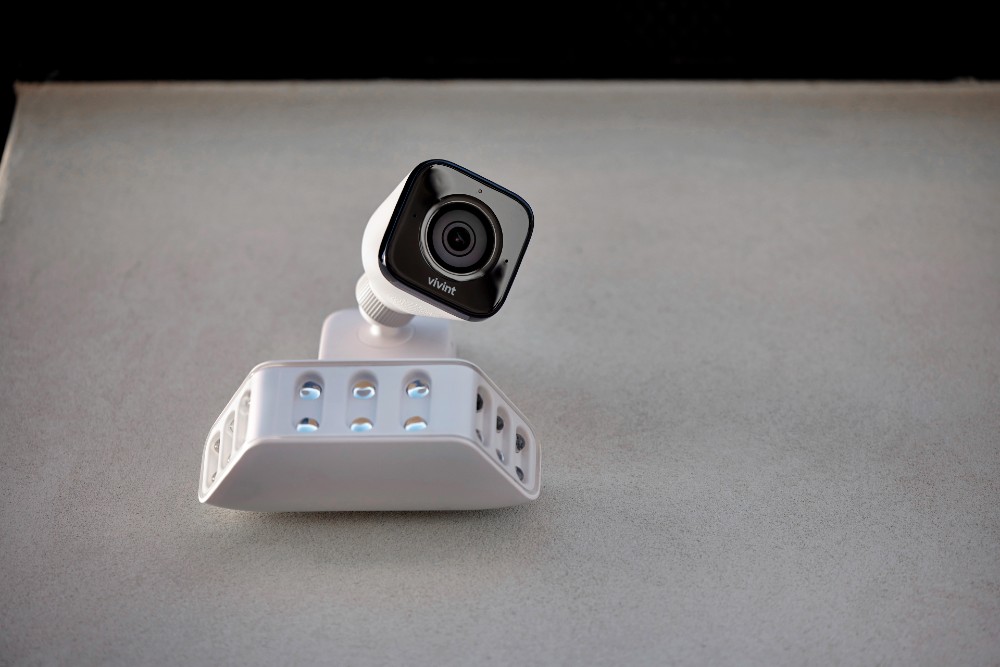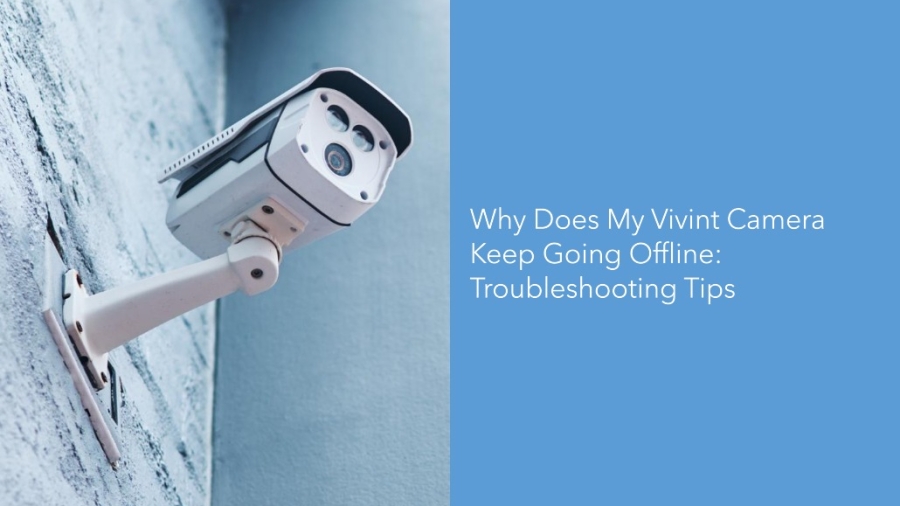Troubleshooting Vivint Camera Offline Problems
Check Internet Connection
The first step in troubleshooting your Vivint camera’s offline issues is to verify the stability and speed of your internet connection. An unstable or slow connection can disrupt your camera’s ability to communicate with the Vivint system. Follow these steps:- Examine your router to ensure it’s on and connected properly.
- Perform a speed test to check for adequate upload and download speeds.
- If other devices are online, verify network bandwidth isn’t being exceeded.
- Assess Wi-Fi signal strength near your camera; weak signals may require a booster or extender.
Power Cycle The Camera
Power cycling can often resolve tech glitches by refreshing the camera’s internal settings. The process is straightforward:- Disconnect your camera from the power source.
- Wait approximately 60 seconds before reconnecting to allow the camera to reset.
- After reconnecting, observe whether the camera goes back online.
Reset The Camera Settings
Resetting your camera to its factory settings can resolve deeper issues that simple restarts cannot fix. However, this should be considered a last resort as it will erase any custom settings.| Step | Action |
|---|---|
| 1 | Locate the reset button on your camera. |
| 2 | Press and hold the reset button for 10-20 seconds. |
| 3 | Wait for the camera to reboot and reconnect to the network. |
| 4 | Reconfigure your camera settings as they were cleared during the reset. |
Ensuring Proper Placement Of Vivint Camera
Experiencing issues with your Vivint camera disconnecting can be frustrating, especially when the purpose of your camera is to provide a constant, vigilant eye over your household or business. Ensuring proper placement of your Vivint camera is not just about capturing the right angle but also about maintaining a reliable connection that prevents your camera from repeatedly going offline. The key aspects to consider include optimal camera positioning and appropriate calibration for outdoor placement.
Optimal Camera Positioning
The placement of your Vivint camera is pivotal in ensuring a stable and uninterrupted connection. To enhance the performance of your device, follow these guidelines:- Distance from the Router: Cameras should be positioned within the Wi-Fi router’s effective range. Too far, and the signal weakens, too close, and it might interfere with the signal.
- Physical Obstructions: Walls, large metal objects, and mirrors can impede Wi-Fi signals. Find a clear path between the camera and the router.
- High Traffic Areas: Position your camera to avoid areas with heavy electronic usage that may disturb the Wi-Fi signal.
- Elevation: Mount your camera high to not only capture a wider area but also keep it away from signal disturbances at ground level.
Calibration For Outdoor Placement
When placing Vivint cameras outdoors, the calibration process is just as important as finding the optimal position:- Ensure the camera has a clear line of sight to the area of interest, free from environmental obstructions like trees and buildings.
- In areas with extreme temperature variations, position the camera under an overhang or within a weather-resistant housing to protect against weather-related disconnections.
- Adjust the camera’s settings for outdoor lighting conditions to maintain a clear connection and image quality, especially during night and adverse weather.
Updating Vivint Camera Firmware
An essential aspect of maintaining your Vivint Smart Home Camera involves regular updates to its firmware. Like your smartphone or computer’s operating system, the software that runs on your Vivint camera is critical for its functionality, security, and performance.
Understanding the Updating Vivint Camera Firmware process can solve a myriad of issues, including the frustrating problem of your camera going offline unexpectedly. Let’s delve into the importance of these updates and the steps needed to ensure your camera operates smoothly.
Importance Of Firmware Updates
First and foremost, firmware updates often come with crucial security patches that protect your camera from potential vulnerabilities. An outdated firmware can leave your camera defenseless against cyber threats, compromising your privacy. Secondly, updates also provide performance enhancements. They can fix bugs or issues that may be causing your camera to disconnect. Lastly, firmware updates can add new features and improve the overall user experience with your Vivint camera.Steps To Update Camera Firmware
Updating your Vivint camera’s firmware is a straightforward process that can be done with minimal hassle. Here’s how to keep your camera running without interruption:- Check Camera Connection: Ensure your camera is online and connected to your home WiFi network.
- Access Vivint Smart Home App: Open the app on your mobile device and log into your account.
- Navigate to Camera Settings: Find and select ‘Device Settings’ for the camera you want to update.
- Find Firmware Update Option: Look for an ‘Update Firmware’ button or similar within the settings.
- Initiate Update: Start the update process and be sure to keep the camera connected during this time.
Addressing Network Interference
A strong and stable network connection is the backbone of any smart home security system. Vivint cameras, renowned for their seamless integration and reliability, can sometimes experience connectivity issues due to network interference. Such instances can cause your cameras to go offline unexpectedly, compromising the security of your home. Identifying and resolving network interference can help in maintaining the robust performance that users expect from their Vivint setup. In this section, we’ll delve into the common sources of interference and provide actionable solutions to keep your cameras connected and functional.
Identifying Potential Interference Sources
Understanding what can cause interference with your Vivint camera’s connection is the first step toward a solution. Common culprits include:- WiFi congestion: Multiple devices on the same network can saturate bandwidth.
- Physical obstructions: Walls, furniture, or appliances that block the signal path.
- Electrical appliances: Devices such as microwaves or cordless phones that operate on similar frequencies.
- Neighbor’s network: Overlapping channels from nearby WiFi networks.
Resolving Interference Issues
Once you’ve pinpointed the potential sources of interference, you can take steps to alleviate the problem and restore your camera’s connectivity.- Reposition your camera closer to the WiFi router to minimize physical obstructions.
- Change the channel or frequency of your WiFi router to reduce the overlap with other devices or networks.
- Limit the number of devices connected to your network or create a dedicated guest network for visitors to keep your main bandwidth free for security devices.
- Invest in a WiFi extender or a mesh network to boost signal strength in larger homes or areas with numerous obstacles.
Verifying Power Supply For Vivint Camera
Dealing with a Vivint camera that frequently loses its connection can be frustrating. One of the critical factors you should consider is the stability and reliability of the power supply to your camera. Cameras operating under fluctuating power conditions are prone to interruptions and unexpected downtimes. In this segment, we dive deep into how to assess your camera’s power source and explore backup power options to keep your security system running smoothly.
Assessing Power Source Stability
Ensuring that your Vivint camera has a stable power source is paramount. A consistent power input keeps the device operational, devoid of any disruptions. Here’s what to check to ensure power source stability:- Examine the power outlet for any signs of damage or wear. A compromised outlet could lead to intermittent power supply.
- Test the outlet with another device to confirm power consistency. If the second device also experiences power interruption, the issue could be with the outlet itself.
- Check the power adapter and cords for any visible damage or loose connections. These could be potential culprits for power fluctuations.
- Utilize a digital multimeter to measure the output voltage of the camera’s power adapter to ensure it matches the recommended specifications.
Backup Power Options
Investing in backup power options can provide your camera with the uninterrupted power it requires to function optimally. Here are actionable steps to consider:- Invest in a Uninterruptible Power Supply (UPS). A UPS can keep your camera running even when the primary power source fails.
- Consider the use of Power over Ethernet (PoE) adaptors. PoE allows your camera to receive both power and data through one network cable, reducing the dependency on power outlets.
- Explore camera-specific backup battery options. Some cameras come with or allow for additional battery packs to be attached, providing you with extra hours of operation in case of an outage.
 Credit: www.vivint.com
Credit: www.vivint.comSeeking Technical Support From Vivint
Encountering issues with your Vivint camera disconnecting can be both frustrating and concerning, impacting your home’s security. But fret not, Vivint has established reliable channels of technical support to swiftly address and resolve such issues. Let’s delve into how you can seek technical support from Vivint to get your camera back online and operational.
Contacting Customer Support
When your Vivint camera keeps going offline, your initial step should be getting in touch with Vivint Customer Support. Their team is equipped to diagnose and troubleshoot common technical difficulties. Here’s how to reach out:- Open your Vivint app and use the customer chat feature for instant support.
- Call their support hotline for direct assistance.
- Email the support team outlining your camera’s issues for in-depth guidance.
Requesting On-site Assistance
In cases where remote troubleshooting doesn’t restore your camera’s connectivity, you may require on-site technical support. Vivint provides this service to ensure a comprehensive resolution. To schedule a visit:- Contact Customer Support to detail the persistent issue.
- Provide a suitable time for the technician’s visit.
- Prepare for the appointment by noting down specifics about the issue’s frequency and conditions.
Understanding Common Vivint Camera Offline Causes
Environmental Factors
Various environmental elements can disrupt the performance of your Vivint security cameras. A stable connection can be compromised by:- Physical Obstructions: Walls, furniture, or other large objects might block the signal between your camera and router or home control panel.
- Wireless Interference: Other wireless devices, like cordless phones or microwaves, operating on the same frequency can cause interference.
- Extreme Temperatures: Vivint cameras are designed to withstand certain weather conditions, but extreme heat or cold can impact the device’s reliability.
Software And Hardware Problems
Your Vivint camera’s performance also heavily relies on its software and hardware. You might encounter offline issues due to:| Software/Hardware Issue | Potential Impact |
|---|---|
| Outdated Firmware | This can lead to security vulnerabilities and connectivity issues |
| Malfunctioning Equipment | Critical failures in the camera’s components can cause it to go offline |
| Incorrect Settings | Improper configuration can interfere with the camera’s operation |
